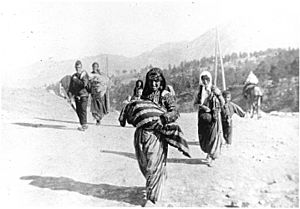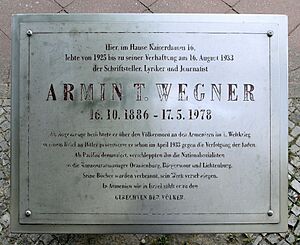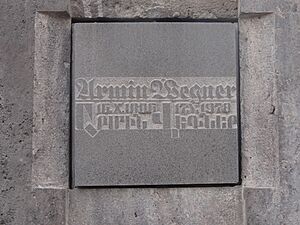Armin T. Wegner facts for kids
Quick facts for kids
Armin T. Wegner
|
|
|---|---|

Wegner in uniform as a young man
|
|
| Birth name | Armin Theophil Wegner |
| Born | October 16, 1886 Elberfeld, Rhine Province, German Empire |
| Died | May 17, 1978 (aged 91) Rome, Italy |
| Allegiance | German Empire |
| Service/ |
German Sanitary Corps |
| Years of service | 1914–1916 |
| Rank | Second Lieutenant |
| Awards | Iron Cross |
| Other work | Am Kreuzweg Der Welten (Berlin, 1982) |
Armin Theophil Wegner (October 16, 1886 – May 17, 1978) was a German soldier and medic during World War I. He was also a talented writer and a strong human rights activist. While serving in the Ottoman Empire during the war, Wegner saw the terrible events of the Armenian genocide. He took many photos that are now very important evidence of what happened.
After World War I, Wegner bravely spoke out against the unfair treatment of Jewish people by the Nazi government. In 1933, he wrote a powerful letter to Adolf Hitler. In this letter, he said that hurting Jewish people would also harm Germany itself. He wrote, "There is no Fatherland without justice!" Because of his actions, the Nazi government persecuted him. He was held in concentration camps before he managed to escape.
After leaving Germany, he lived the rest of his life in Italy. Later, he was honored for his efforts against genocide. Yad Vashem recognized him as one of the Righteous Among the Nations. His story and photos have helped many people learn about the Armenian genocide.
Contents
Who Was Armin Wegner?
Early Life and Learning
Armin Wegner was born in Elberfeld, a town in the German Empire. This area is now part of Wuppertal, Germany. He first studied in Striegau, which is now Strzegom. Later, he continued his studies in Zürich, Wrocław, and Berlin. After finishing his law studies, he joined the army.
His Role in World War I
Wegner joined the German army when World War I began in 1914. He worked as a medic in Poland and was given the Iron Cross award for helping injured soldiers during battles. He became a second lieutenant in the German Sanitary Corps. This group worked with the Ottoman Sixth Army. Wegner was in Syria and Mesopotamia, where he saw the forced marches of Armenians. These marches were part of the Armenian genocide.
The Ottoman government and Germany were allies, and they wanted to keep the massacres a secret. But Wegner ignored these orders. He gathered information, documents, notes, and letters. He also took hundreds of photos in the Armenian deportation camps in Deir ez-Zor. These photos later proved the terrible things that happened to the Armenians. The Ottoman command asked for Wegner to be arrested by the Germans and sent back to Germany. Some of his photos were taken and destroyed, but he managed to hide many negatives in his belt and smuggle them out.
After the war, in 1919, Wegner wrote an open letter about the terrible acts against the Armenian people. It was published in a newspaper and sent to American President Woodrow Wilson. In the letter, Wegner argued for an independent Armenian state. In the same year, he published a book called Der Weg ohne Heimkehr (The Road of No Return). This book was a collection of letters he wrote about what he called the "martyrdom" of the Armenians.
After the War: The Weimar Period
Back in Germany, Wegner married author Lola Landau. He became an activist who believed in pacifism, which means opposing war and violence. He strongly supported the idea of a separate Armenian nation. He also tried to blame the Young Turk government for the atrocities, not the Turkish people as a whole.
In 1921, Wegner spoke at the trial of Soghomon Tehlirian. Tehlirian was an Armenian who had killed Talat Pasha in Berlin. Talat Pasha was a former Ottoman minister who had been sentenced to death for planning the Armenian massacres. Wegner's job at the trial was to confirm how terrible the Armenian experience was during the genocide. Tehlirian was found not guilty, even though he killed Talat Pasha in front of witnesses. This was because the court decided he was temporarily insane. Wegner wrote the introduction for a book about this famous trial.
In 1922, Wegner published Der Schrei von Ararat (The Scream from Ararat). This book was an appeal for the rights of Armenians who survived. By the mid-1920s, Wegner became very popular as a writer. He was also a key figure in a German art movement called Expressionism. In 1927–28, he and his wife traveled to the Soviet Union. They also visited the Armenian Soviet Socialist Republic, where he met some Armenians he had befriended earlier. After this trip, Wegner wrote Five Fingers Over You. This book was a big success and made him even more famous. It described the harsh political violence of the Soviet Communist system, even before Stalinism fully took hold.
Facing the Nazis
On April 11, 1933, soon after the Nazi boycott of Jewish businesses, Wegner publicly spoke out against the persecution of Jews in Germany. He wrote an open letter to Adolf Hitler. On September 19, the Gestapo (Nazi secret police) arrested him. He was imprisoned and treated badly. He was held in several Nazi concentration camps, including Oranienburg and Lichtenburg. He was released in 1934 and escaped to Rome, Italy. There, he lived under a different name. In 1939, he and his wife Lola Landau divorced. He later said that Germany "took everything from me... even my wife." In 1945, he married Irene Kowaliska.
Some historians say that Wegner was a "broken man" by the 1960s. They suggest that his efforts to save Jewish people from the Nazis were not successful.
His Lasting Impact
In 1956, Wegner received the highest Order of Merit from the German government. His hometown of Wuppertal gave him the important Eduard-Von-der-Heydt prize in 1962. In 1967, Yad Vashem gave him the title of Righteous Among the Nations. A year later, he was invited to Armenia and received the Order of Saint Gregory the Illuminator.
Armin Wegner died in Rome at the age of 91. Some of his ashes were later taken to Armenia. They were honored at a special funeral near the Armenian Genocide Monument's eternal flame.
In 2000, a documentary film called Destination: Nowhere (The Witness) was made. It showed Wegner's personal story of the Armenian genocide through his own photographs. Before the film was released, he was honored at the Armenian Genocide Museum in Yerevan for his lifelong support of Armenians.
Some people remember Wegner as "the only writer in Nazi Germany ever to raise his voice in public against the persecution of the Jews." However, by the time he died in Rome, many Germans had almost forgotten him. He never felt truly at home in Germany after fleeing in the 1930s. He lived the rest of his life in Italy. The words on Wegner's gravestone are similar to the last words of Pope Gregory VII from 1085.
See also
 In Spanish: Armin T. Wegner para niños
In Spanish: Armin T. Wegner para niños
- Witnesses and testimonies of the Armenian genocide




